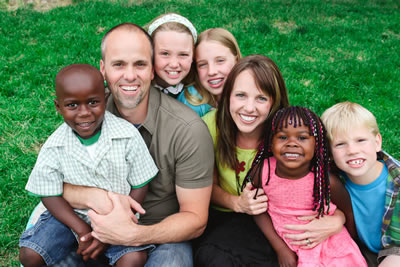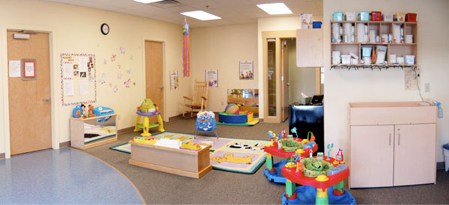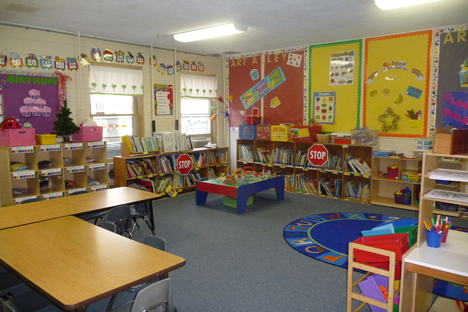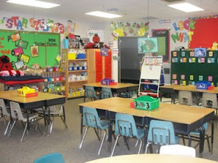Lesson 13: Environments and Families

Learning Outcomes
Upon completion of this lesson's material, students will be able to:
- Discuss the importance of the environment in early childcare settings.
- Demonstrate a method of creating a relationship with families
Teaching
Watch Aspects of Early Childhood Classroom Design
Environment – the physical space and the “feeling” of the setting – Is the environment welcoming? Do the caregiver and children look comfortable in the environment? Is the environment age appropriate? Is the environment safe?
Physically it is important how the room is arranged. It is important to consider how many children and adults will be using the space. Each state has regulations on the minimum square footage per child. Thought must be given to noisy activities and quiet activities, as well as areas for resting. Consideration as to the type of flooring is important; which areas are carpeted, which have hard flooring? Traffic patterns are important as well. Is there enough space in between furniture for walking but not so much that it will inspire running? Furniture must be arranged so the caregivers can see all areas of the classroom at all time.
Changing areas or bathrooms must be conveniently located yet away from certain other areas (feeding).
Books in the early childhood setting are so important. Children love to be read to and to practice reading on their own. Reading helps children of all ages make sense of their world. Caregivers can help support a positive attitude toward reading. The connection between reading and writing is inherent and should be encouraged. Reading to children also creates a bond. It can be made fun. I remember a preschool classroom creating a rap to the words of A People House by Dr. Seuss. It was really fun to see the children and teachers get into rapping the rhymes and then to the the children later doing it on their own.
Outdoor space deserves special consideration. Again, age appropriateness is important.. The outdoor play areas must be checked prior to the children playing in them. We spoke previously about some environmental concerns. Also consider bees may nest in playground equipment. Equipment must be in good repair and consideration given to the types of materials. A shady area should be available.
Safety is essential inside and outside. A good way to check for safety is to get on the child’s level, on your hands and knees. Are there sharp corners or edges, loose rugs, outlet covers, hanging cords, extension cords, tripping hazards, open stairs, or cleaning supplies stored within reach? Water temperature must be appropriate. Playground equipment must be appropriate height for age groups and provide enough spaces in between. A first aid must be available (regulations list what is required), and smoke detectors, carbon monoxide detectors, and fire extinguishers must meet regulation requirements. You will need to make sure there are not any poisenous plants and assure children do not have any allergies to potential animals in your setting.
Caution – adult personal belongings must be kept away from children. Medications and other adult items might be considered candy by children. It is also a good idea to regularly scan the floors in case something is dropped from a purse or bag during drop off or pick up. Cleaning supplies must be kept out of reach of children and caution to vapors that may be released.
In addition to spaces for children, the environment must be appropriate to adults. The caregivers need places to work uninterrupted, store confidential documents, store supplies, and places for their personal needs. Parents will also be dropping off and picking up children. There must be a location for saying goodbye, storing children’s daily materials, and a place or method for communications between parents/caregivers.
The environment must be welcoming to the children, caregivers, and families. Natural lighting is wonderful, if it is an option. Noise level in a room can also be welcoming or over-whelming. The temperature must be appropriate. Routines are important but should not be so strictly adhered to that they become rigid. Transitions can be a difficult time for some children. Changing from one activity to another can be over-whelming and may interrupt their activities.
When one of my children was in preschool, I became concerned over the tone of the environment. She had been going there for several months when suddenly as she entered the setting, none of the caregivers were greeting her. I started to observe when I was dropping her off and realized it had been happening for about a week. I questioned if there was an issue. In front of other parents dropping off, this caregiver started telling me she thought my daughter had "a brain issue" (as she tapped the side of her head) because she did not play with the other girls and played with the boys. I asked if a conference was necessary, to indicate I wanted privacy. She said no. So I ended the conversation and removed my daughter from the setting. This story demonstrates the importance of greeting every child every day. As they transition from home to child care, they may experience different feelings. It is essential that they are made to feel welcome and valued.
Infant/Toddler Environment

Preschool Environment

Families
As you think about setting up an environment, you MUST consider how it would feel for a family to walk in. The little things that people often look over are as simple as extra coat hooks at their level, a message board, a special area for them to settle in their children with a book or photo. Beyond the entry way and into the classroom, have you put up family photos or displayed pieces of their culture such as occupation, recreation etc.
All of these small pieces add up and contribute to creating an environment that is not only welcoming for the children but for the families too!
Families are important to early childhood programs. There must be a level of trust for them to leave their children in the care of others. Families are very different than they were in the past. Early childhood educators must be accepting of all types of families. They must also be careful to not judge any family and maintain confidentiality. Families must work with caregivers to do what is best for the child. Communicating with families on a regular basis is an important part of an early childcare setting.
Many settings struggle with their environment and interactions with families who are so diverse from themselves; families from poverty, families with varying disabilities, families from another country.
Assessment
Lesson 13 Assignment
From your Early Years Matter text chose to read about one of the following:
- Low income Families and Violence and Stress (chapters 5&6)
- Children with Disabilities and Children with Challenging Behaviors (chapters 7&8)
- Children in Immigrant Families and Children in Developing Countries (chapters 9&10)
As you read this chapter think about it from the lens of an educator and how you would set up your environment to support children and families in that particular group.
For the assignment you will:
- Summarize your understanding of findings in the chapters
- Define the age range of the environment you are envisioning
- Summarize the major things you will do to the environment to welcome children and families according to
- Entrance area
- Décor
- Classroom materials
- Classroom design
- Menu
- Other
- Discuss why your choices (in each area) are important to respect the group of children and families you chose to read about
CHAPTERS SUMMARY |
0 Points Did not provide summary |
5 Points Provided some detail, with few examples, about the chapters you read and what knowledge you gained about the families you read about |
10 Points Provided a detailed summary, with examples, about the chapters you read and what knowledge you gained about the families you read about |
AGE RANGE |
0 Points Did not provide age range |
|
5 Points Provided age range (0-3 classroom, 3-5 classroom or school age |
SUMMARY OF ENTRANCE AREA |
0 Points Did not provide summary |
5Points Provided some detail, with few examples, of how your entrance area into the classroom will provide a respectful, safe, welcoming areas for the families you read about |
10 Points Provided detailed summary, with examples, of how your entrance area into the classroom will provide a respectful, safe, welcoming areas for the families you read about |
SUMMARY OF DECOR |
0 Points Did not provide summary |
5 Points Provided some details, with few examples, of how you will decorate your classroom to respect the children and families you read about |
10 Points Provided detailed summary, with examples, of how you will decorate your classroom to respect the children and families you read about |
SUMMARY OF CLASSROM MATERIALS |
0 Points Did not provide summary |
7Points Provided detailed summary, with examples, of classroom materials you will have out that respect and provide intentional experiences to the children and families you read about |
15 Points Provided detailed summary, with examples, of classroom materials you will have out that respect and provide intentional experiences to the children and families you read about |
SUMMARY OF CLASSROOM DESIGN |
0 Points Did not provide summary |
7 Points Provided some detailed, with few examples, of how you will design classroom that respects and provides intentional experiences to the children and families you read about |
15 Points Provided detailed summary, with examples, of how you will design classroom that respects and provides intentional experiences to the children and families you read about |
SUMMARY OF MENU |
0 Points Did not provide summary |
5 Points Provided a brief summary of the different types of food you will serve and utensils used |
10 Points Provided a detailed summary of the different types of food you will serve and utensils used to respect the children and families you read about |
RATIONALE OF CHOICES |
0 Points Did not provide description |
7 Points Provides a rationale, with few examples that explains your choices for each area |
15 Points Provides a detailed rationale, with examples that explains your choices for each area |
MECHANICS |
0 Points Paper is written with unacceptable spelling, grammar, and/or syntax errors |
5 Points Errors in mechanics are minor, but are somewhat distracting from the message. |
10 Points No substantial errors in spelling, grammar, and/or syntax, or APA Citations. |
Lesson 13 Discussion
Consider an early childhood environment. We all have elements of the environment that we consider essential. Identify something not discussed in the notes that you consider an important part of the environment. Discuss why is it important.
